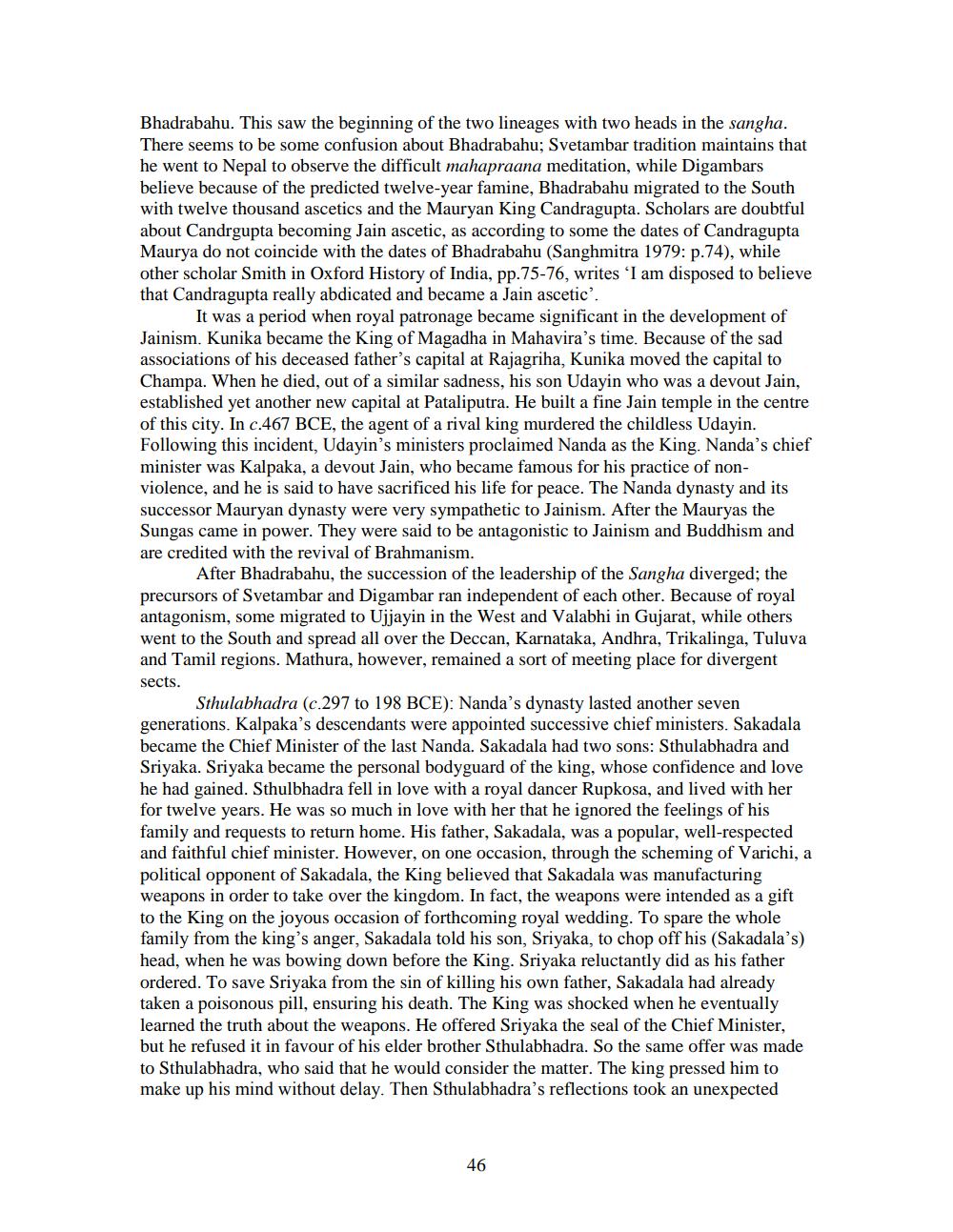________________
Bhadrabahu. This saw the beginning of the two lineages with two heads in the sangha. There seems to be some confusion about Bhadrabahu; Svetambar tradition maintains that he went to Nepal to observe the difficult mahapraana meditation, while Digambars believe because of the predicted twelve-year famine, Bhadrabahu migrated to the South with twelve thousand ascetics and the Mauryan King Candragupta. Scholars are doubtful about Candrgupta becoming Jain ascetic, as according to some the dates of Candragupta Maurya do not coincide with the dates of Bhadrabahu (Sanghmitra 1979: p. 74), while other scholar Smith in Oxford History of India, pp.75-76, writes 'I am disposed to believe that Candragupta really abdicated and became a Jain ascetic'.
It was a period when royal patronage became significant in the development of Jainism. Kunika became the King of Magadha in Mahavira's time. Because of the sad associations of his deceased father's capital at Rajagriha, Kunika moved the capital to Champa. When he died, out of a similar sadness, his son Udayin who was a devout Jain, established yet another new capital at Pataliputra. He built a fine Jain temple in the centre of this city. In c.467 BCE, the agent of a rival king murdered the childless Udayin. Following this incident, Udayin's ministers proclaimed Nanda as the King. Nanda's chief minister was Kalpaka, a devout Jain, who became famous for his practice of nonviolence, and he is said to have sacrificed his life for peace. The Nanda dynasty and its successor Mauryan dynasty were very sympathetic to Jainism. After the Mauryas the Sungas came in power. They were said to be antagonistic to Jainism and Buddhism and are credited with the revival of Brahmanism.
After Bhadrabahu, the succession of the leadership of the Sangha diverged; the precursors of Svetambar and Digambar ran independent of each other. Because of royal antagonism, some migrated to Ujjayin in the West and Valabhi in Gujarat, while others went to the South and spread all over the Deccan, Karnataka, Andhra, Trikalinga, Tuluva and Tamil regions. Mathura, however, remained a sort of meeting place for divergent sects.
Sthulabhadra (c.297 to 198 BCE): Nanda's dynasty lasted another seven generations, Kalpaka's descendants were appointed successive chief ministers. Sakadala became the Chief Minister of the last Nanda. Sakadala had two sons: Sthulabhadra and Sriyaka. Sriyaka became the personal bodyguard of the king, whose confidence and love he had gained. Sthulbhadra fell in love with a royal dancer Rupkosa, and lived with her for twelve years. He was so much in love with her that he ignored the feelings of his family and requests to return home. His father, Sakadala, was a popular, well-respected and faithful chief minister. However, on one occasion, through the scheming of Varichi, a political opponent of Sakadala, the King believed that Sakadala was manufacturing weapons in order to take over the kingdom. In fact, the weapons were intended as a gift to the King on the joyous occasion of forthcoming royal wedding. To spare the whole family from the king's anger, Sakadala told his son, Sriyaka, to chop off his (Sakadala's) head, when he was bowing down before the King. Sriyaka reluctantly did as his father ordered. To save Sriyaka from the sin of killing his own father, Sakadala had already taken a poisonous pill, ensuring his death. The King was shocked when he eventually learned the truth about the weapons. He offered Sriyaka the seal of the Chief Minister. but he refused it in favour of his elder brother Sthulabhadra. So the same offer was made to Sthulabhadra, who said that he would consider the matter. The king pressed him to make up his mind without delay. Then Sthulabhadra's reflections took an unexpected
46




